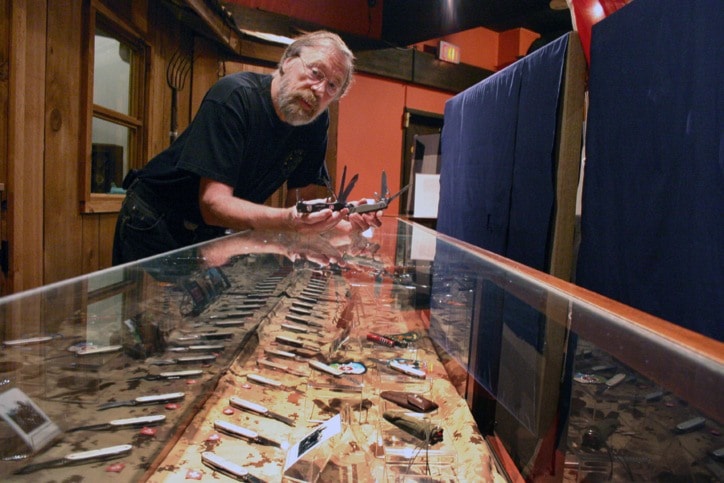There’s a new, cutting-edge display at the Port Hardy Museum. It’s really is a slice, but you’ll have to wait until next week when the museum reopens to see it.
Port Hardy’s own Rick Kirkpatrick is a collector of the soldier’s style of Swiss Army knives and has donated dozens to be put on display at the North Island local museum.
“I was always interested in knives and was in Calgary once when a sports shop had them on sale,” Kirkpatrick recalled. “I saw a pioneer knife, which is exactly the same as the soldier’s knife except it had a key chain on it, but that’s what got me started.”
That one knife soon turned into five, then 10, then 20 until finally, Kirkpatrick said he reckons he has about 50 in the collection.
“The affection grows stronger the more you collect, but there’s not enough time or money in the world to buy every knife you want,” he said.
The soldier’s style of the army knives — first issued to Swiss soldiers in 1891 — had only a straight blade, a screwdriver for military rifles, a can opener, an awl and grips made out of dark oak wood that were later partly replaced with ebony.
No Swiss company at the time was capable of producing the knives, so the initial order of 15,000 was placed with Wester & Co. of Solingen, Germany.
In 1897 the knife morphed into one that featured a second smaller cutting blade, corkscrew and wood fibre grips.
It was originally registered with the patent office as the Officer’s and Sports Knife, though it was never part of a military contract.
“The government didn’t go for it,” Kirkpatrick said.
“It was only the officers knife that had the corkscrew because, as everyone knows, ordinary soldiers never drank wine,” he smiled.
The company producing the knives eventually went ahead with the now familiar red plastic version for general consumerism and a lot has changed over the years for the Swiss Army Knives.
The name is familiar, but they weren’t called that when Swiss soldiers carried them.
They were known as Schweizer Offiziersmesser and the term Swiss Army Knife was coined by returning Second World World U.S. soldiers who had trouble pronouncing the German name.
In addition to the main blade, the most common tools featured on those knives included a smaller second blade, tweezers, a toothpick, corkscrew, can opener, bottle opener, slotted/flat-head screwdriver, Phillips-head screwdriver, nail file, scissors, wood saw, a file, hook — for tightening shoelaces, etc.— magnifying glass, ballpoint pen, fish-scaler, hex wrench with bits, pliers, and a keyring.
Newer versions of the knife also include things like USB flash drives, a digital clock, digital altimeter, LED light, laser pointer and MP3 player.
The pocket knives, or multi-tools, are now manufactured by Wenger SA and Victorinox AG — the latter also known for it’s line of kitchen and restaurant knives — that produces 23-million knives a year.
“But the production run for the military knives is a day and-a-half,” said Kirkpatrick.
The museum is scheduled to reopen Monday.
